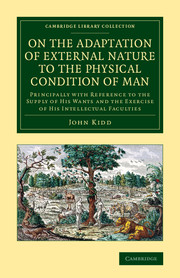-
Select format
-
- Publisher:
- Cambridge University Press
- Publication date:
- December 2014
- July 2014
- ISBN:
- 9781107255968
- 9781108069649
- Dimensions:
- Weight & Pages:
- Dimensions:
- (216 x 140 mm)
- Weight & Pages:
- 0.5kg, 396 Pages
You may already have access via personal or institutional login
Book description
Having studied medicine at Guy's Hospital, London, John Kidd (1775–1851) established himself as a physician and educator at Oxford, where he lectured widely on chemistry, anatomy, mineralogy and geology. Regius professor of medicine and a fellow of the Royal Society from 1822, he rooted his scientific understanding and teaching in natural theology. Published in 1833 as the second Bridgewater Treatise, the present work attempted to bring science and religion into harmony, drawing on such disciplines as anthropology and comparative anatomy. Seeking to demonstrate the superiority of humans in the natural world, Kidd argues that animals, minerals and plants had been adapted by God to serve mankind. Founded upon a belief in the antediluvian world and the revealed existence of God in nature, the work exemplifies the influence of natural theology within the scientific establishment before the era of Darwin.
Contents
Metrics
Full text views
Full text views help Loading metrics...
Loading metrics...
* Views captured on Cambridge Core between #date#. This data will be updated every 24 hours.
Usage data cannot currently be displayed.
Accessibility standard: Unknown
Why this information is here
This section outlines the accessibility features of this content - including support for screen readers, full keyboard navigation and high-contrast display options. This may not be relevant for you.
Accessibility Information
Accessibility compliance for the PDF of this book is currently unknown and may be updated in the future.



